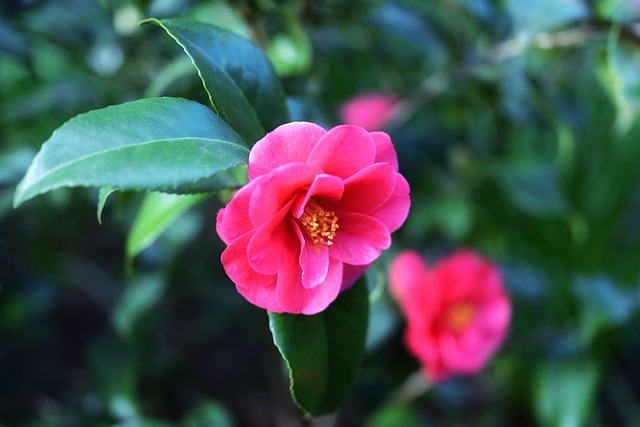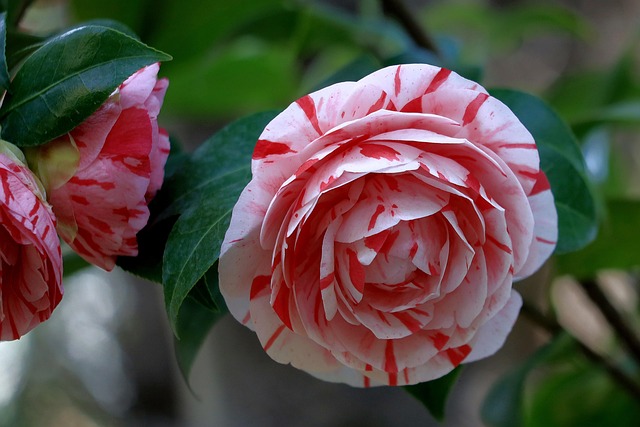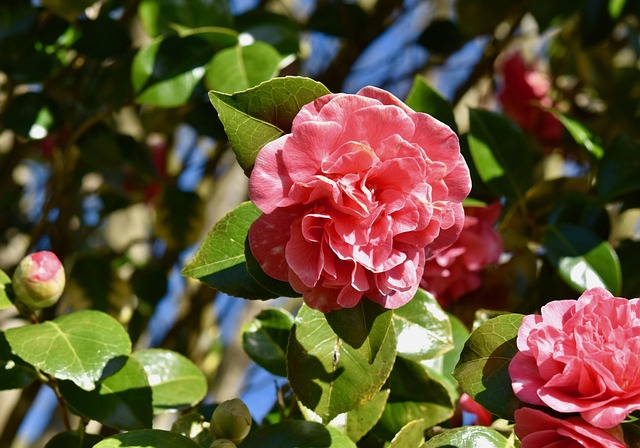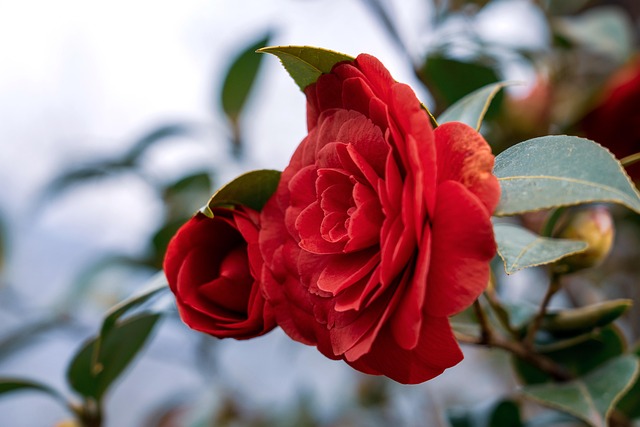Japanese camellias, known as tsubaki in Japan, represent one of the most culturally significant and botanically diverse flowering plants in Japanese horticulture. With over 30,000 cultivars developed worldwide and more than 250 varieties thriving in Japan alone, these evergreen beauties have captivated gardeners and nature enthusiasts for over 1,300 years.
Unlike their more commonly known tea-producing cousin (Camellia sinensis), Japanese camellia varieties (Camellia japonica) have been specifically cultivated for their stunning winter and early spring blooms. These remarkable plants bloom during the coldest months when most other flowering plants remain dormant, making them invaluable for adding color and beauty to winter landscapes.
From the wild native species found in Japan’s mountain forests to the meticulously bred cultivars gracing imperial gardens, Japanese camellias offer an extraordinary range of flower forms, colors, and cultural significance that continues to inspire gardeners worldwide.
What Makes Japanese Camellia Varieties Special
Native Origins and Botanical Characteristics
Camellia japonica is indigenous to Japan, southern Korea, Taiwan, and parts of eastern China, with Japan serving as the primary center for cultivation and breeding innovation. The species naturally occurs in mountain forests at altitudes ranging from 300 to 1,100 meters, where it has adapted to various climatic conditions over millennia.
The Japanese name “tsubaki” derives from either “Atsu-ba-ki” meaning “thick-leaf tree” or “Tsuya-ba-ki” translating to “glossy-leaf tree,” both references highlighting the plant’s distinctive evergreen foliage. This leathery, dark green foliage remains beautiful year-round, providing structural interest in gardens even when the plants aren’t flowering.
Archaeological evidence suggests that Japanese people have utilized camellias for over 2,300 years, dating back to the Jomon period. The seeds were processed into oil for cooking, lamp fuel, and hair care, while the dense, durable wood was prized for crafting tools and decorative items.
Unique Features of Japanese Tsubaki
What distinguishes Japanese camellia varieties from other flowering shrubs is their remarkable winter blooming habit. While most plants enter dormancy during cold months, camellias burst into bloom from late winter through early spring, providing essential nectar for early pollinators and stunning visual interest when gardens appear most barren.
The flowers themselves demonstrate extraordinary diversity in form, ranging from simple single blooms with prominent golden stamens to complex formal doubles with hundreds of layered petals. Japanese breeders have developed varieties with flowers spanning from miniature 1.5-inch blooms to massive 5-inch specimens, each with unique petal arrangements and color patterns.
Another distinctive characteristic is how camellia flowers end their blooming cycle. Unlike many flowers that drop petals individually, entire camellia blooms fall intact, creating a carpet of perfect flowers beneath the plant. This phenomenon, called “ochi tsubaki” in Japanese, has inspired countless poets and artists while also creating cultural taboos around gifting camellias to hospitalized individuals.
Major Japanese Camellia Species and Varieties

Camellia japonica (Common Japanese Camellia)
Camellia japonica represents the most widespread and economically important species within the Japanese camellia family. In its wild form, this species typically grows as a small tree reaching 20-30 feet in height, though cultivated varieties often remain smaller and more manageable for garden use.
The species demonstrates remarkable adaptability, thriving in habitats ranging from coastal areas to mountainous regions. Wild specimens produce relatively simple flowers, usually in shades of red, pink, or white, with single or semi-double forms being most common. These wild varieties served as the genetic foundation for thousands of cultivated forms developed over centuries.
Modern Camellia japonica cultivars showcase an astounding range of characteristics. Popular varieties include:
- ‘Kramer’s Supreme’: An award-winning cultivar featuring brilliant red, fully double flowers with a sweet fragrance
- ‘Daikagura’: An ancient Japanese cultivar with large rose-red flowers blotched white, considered one of the greatest camellias of all time
- ‘White by the Gate’: Produces pure white, formal double blooms that resemble wedding bouquet flowers
Camellia rusticana (Snow Camellia)
Camellia rusticana, commonly known as “yuki-tsubaki” or snow camellia, represents one of the most remarkable adaptations in the plant kingdom. This variety naturally occurs in the heavy snowfall regions of northern Honshu, where it survives being completely buried under snow depths of up to 8 feet for up to six months annually.
The snow camellia’s survival strategy involves flexible diagonal trunks that can lie flat beneath snow cover without breaking, combined with a unique ability to survive extended periods without sunlight while maintaining their evergreen leaves. This extraordinary resilience has made snow camellias symbols of perseverance and endurance in Japanese culture.
Snow camellias typically produce smaller flowers than their southern cousins, usually in shades of pink to rose-red, blooming from April to May after the snow melts. The flowers often display a more delicate appearance with slightly hairy leaf bases and smooth outer sepals.
Popular Cultivated Varieties
Japanese breeders have developed numerous prestigious cultivated varieties that showcase the full potential of camellia breeding. Some notable examples include:
Ancient Heritage Varieties:
- ‘Shiragiku’ (1681): Also known as ‘Purity’, featuring large white formal double flowers
- ‘Hikaru-Genji’ (1859): Medium-sized, fragrant flowers with red-pink petals edged in white
- ‘Amabilis’: Known in Japan as ‘Yukimi Guruma’ (Snow Viewing Carriage), produces large single white flowers
Modern Breeding Achievements:
- ‘Unryu’: The zigzag camellia with distinctive branching patterns resembling a dragon climbing to the sky
- ‘Kingyo-tsubaki’: The fishtail camellia with uniquely shaped leaf tips
- ‘Black Tie’: Features dark red formal double flowers with dense upright growth
| Variety Name | Origin Period | Flower Form | Color | Special Features |
|---|---|---|---|---|
| Daikagura | Pre-1891 | Peony Form | Rose-red with white | Ancient cultivar, worldwide recognition |
| Shiragiku | 1681 | Formal Double | Pure White | Oldest named variety |
| Hikaru-Genji | 1859 | Peony Form | Pink with white edges | Fragrant, narrow pointed leaves |
Flower Forms and Color Classifications

Traditional Flower Forms
Japanese camellia breeders have developed a sophisticated classification system for flower forms, each with specific characteristics and cultural significance. The main traditional forms include:
Single Form: Features 5-8 petals in a single row with prominent stamens visible. This natural form closely resembles wild camellias and is highly valued in Japan for its simple beauty and strong connection to nature.
Semi-Double Form: Contains 2-3 rows of petals with some stamens visible. This intermediate form bridges the gap between natural simplicity and bred complexity.
Formal Double: Displays multiple rows of overlapping petals arranged in perfect symmetry with no stamens visible. These flowers represent the pinnacle of breeding achievement and are often used in ceremonial contexts.
Peony Form: Features numerous loose, irregular petals often mixed with petaloids (modified stamens), creating a full, ruffled appearance similar to peony flowers.
Anemone Form: Combines outer petals surrounding a center of petaloids, creating a distinctive two-tier appearance that’s particularly striking in garden settings.
Color Range and Patterns
Japanese camellia varieties demonstrate an impressive spectrum of colors and patterns, though true blue and yellow remain absent from the camellia palette. The available color range includes:
Pure Colors:
- White: From creamy ivory to pure snow white
- Pink: Ranging from pale blush to deep rose
- Red: Spanning from bright cherry red to deep crimson
Complex Patterns:
- Striped: Featuring contrasting stripes or sectors of different colors
- Blotched: Displaying irregular patches of contrasting colors
- Picotee: Showing colored edges on lighter petals
- Marbled: Presenting subtle color variations throughout the petals
The intensity and exact patterns can vary significantly based on growing conditions, temperature, and plant maturity, making each flowering season unique for individual plants.
Cultural Significance and History in Japan

Symbolism in Japanese Culture
In Japanese culture, camellias carry profound symbolic meanings that have evolved over centuries. The red camellia traditionally represents courage, passion, and deep love, while white camellias symbolize purity and perfect beauty. Pink varieties often represent longing and gentle affection.
The way camellia flowers fall – dropping intact rather than petal by petal – has created complex cultural associations. While some view this as symbolizing noble death or the samurai’s honorable end, others interpret it as representing the completeness and integrity of true love, where partners remain united even in death.
During the Edo period, hidden Christians on the Goto Islands adopted the camellia as a secret symbol, associating the flower with the Virgin Mary and spiritual endurance. Many churches on these islands still bear camellia imagery today, testament to the flower’s role in Japan’s religious history.
Historical Background and Tea Connection
The documented history of camellia cultivation in Japan extends back to 685 CE, when Emperor Tenmu received camellias as a tribute gift. However, archaeological evidence suggests utilitarian use of camellia seeds and oil dates back over 2,300 years to the Jomon period.
The Muromachi period (1338-1573) marked the beginning of serious ornamental cultivation, as samurai class members began appreciating the flower’s beauty and incorporating camellias into garden designs, flower arranging, and tea ceremony practices.
During the Edo period, the Tokugawa shogun family, particularly Tokugawa Hidetada, showed exceptional fondness for camellias, leading to the Kan’ei era camellia boom in 1624. This period saw intensive breeding efforts and the development of many classic varieties still prized today.
The connection between camellias and tea culture extends beyond their botanical relationship as family members (Theaceae). Camellia flowers became important elements in tea ceremony arrangements, with their winter blooming period providing essential floral material during seasons when few other flowers were available.
Growing Japanese Camellia Varieties

Ideal Growing Conditions
Successfully cultivating Japanese camellia varieties requires understanding their specific environmental preferences developed over centuries in their native mountain habitats. These plants thrive in conditions that mimic the filtered light and consistent moisture of Japanese forest understories.
Light Requirements: Camellias prefer partial shade, particularly protection from intense afternoon sun. In Japan’s natural habitat, they grow beneath deciduous canopies that provide bright, filtered light. Morning sun combined with afternoon shade typically produces the best flowering and foliage.
Soil Preferences: Well-draining, slightly acidic soil (pH 5.5-6.5) rich in organic matter provides optimal growing conditions. Japanese gardeners traditionally amend soil with composted leaves, creating the loose, fertile conditions camellias require for healthy root development.
Climate Considerations: Most Japanese camellia varieties are hardy in USDA zones 7-9, though some cold-hardy cultivars can survive in zone 6 with proper protection. The key is consistent moisture without waterlogging and protection from drying winter winds.
Moisture Management: Consistent soil moisture proves crucial, especially during bud development in late summer and fall. However, camellias cannot tolerate waterlogged conditions, making proper drainage essential for long-term plant health.
Care and Maintenance Tips
Planting Technique: Japanese tradition emphasizes planting camellias at the same depth they grew in their nursery containers, with the crown slightly exposed. Digging planting holes 3-4 times wider than the root ball, but not deeper, reduces competition from surrounding plants.
Fertilization Schedule: Apply balanced, slow-release fertilizer in early spring, late spring, and mid-summer. Avoid fertilizing after August, as late-season feeding can promote tender growth susceptible to winter damage.
Pruning Practices: Prune immediately after flowering and before fall to avoid removing next year’s flower buds. Japanese gardeners often practice selective pruning to maintain natural form while enhancing air circulation and light penetration.
Mulching Strategy: Apply thick organic mulch around the base in fall to insulate shallow roots from freezing temperatures. Traditional materials include pine needles and shredded leaves, which gradually decompose to improve soil structure.
Pest and Disease Management: Common issues include scale insects, petal blight, and root rot. Maintaining proper air circulation, avoiding overhead watering, and promptly removing infected plant material help prevent most problems.
| Care Aspect | Spring | Summer | Fall | Winter |
|---|---|---|---|---|
| Watering | Consistent moisture | Deep, regular watering | Maintain moisture | Reduce frequency |
| Fertilizing | First application | Second application | Stop feeding | No fertilizer |
| Pruning | Post-bloom pruning | Light shaping | Avoid pruning | Emergency only |
Famous Camellia Gardens:
For those interested in experiencing Japanese camellia varieties firsthand, several world-renowned gardens showcase extensive collections:
Seattle Japanese Garden houses 32 different camellia varieties, with 23 being Camellia japonica cultivars. Their collection blooms from late winter through early spring, providing spectacular displays during the garden’s opening season.
Jindai Botanical Garden in Tokyo features an impressive collection of 620 camellia trees representing 260 different varieties. Their annual Camellia Week in March celebrates the peak blooming period with special exhibitions and educational programs.
User Experiences from Social Media:
“I recently started using Oshima Tsubaki Japanese Camellia Oil, and it’s been a game changer for my skincare and hair care routine! The oil is lightweight and absorbs quickly, leaving my skin feeling soft and moisturized without any greasy residue.” – Amazon reviewer sharing their experience with traditional camellia products.
Instagram users frequently share stunning photos of Japanese camellias in bloom, with many commenting on the flowers’ ability to provide hope and beauty during winter’s darkest months. The hashtag #tsubaki regularly features both garden photography and traditional cultural references.
【References】For readers interested in learning about other traditional Japanese flowers with deep cultural significance:

【References】Those fascinated by Japanese flower culture might also enjoy exploring the seasonal beauty of:

Summary
Japanese camellia varieties represent far more than beautiful flowering plants – they embody centuries of horticultural expertise, cultural significance, and artistic inspiration. From the hardy snow camellias surviving beneath meters of snow to the elegant formal doubles gracing imperial gardens, these remarkable plants showcase the full spectrum of natural adaptation and human breeding achievement.
The diversity within Japanese camellia varieties offers something for every gardener and cultural enthusiast. Whether drawn to ancient cultivars like ‘Daikagura’ with its rich historical significance, or modern breeding achievements featuring unique forms and colors, these plants provide year-round beauty and deep connections to Japanese culture.
Understanding the proper care requirements and cultural context enhances both the growing experience and appreciation for these extraordinary plants. As winter-blooming evergreens, Japanese camellias fill a unique ecological and aesthetic niche, providing essential early nectar sources while creating stunning garden focal points during the season’s most challenging months.
The legacy of Japanese camellia varieties continues to evolve, with ongoing breeding programs developing new cultivars while preservation efforts maintain ancient varieties for future generations. For anyone seeking to bring a piece of Japan’s natural heritage into their garden, these remarkable plants offer an opportunity to participate in a living tradition spanning over thirteen centuries.


